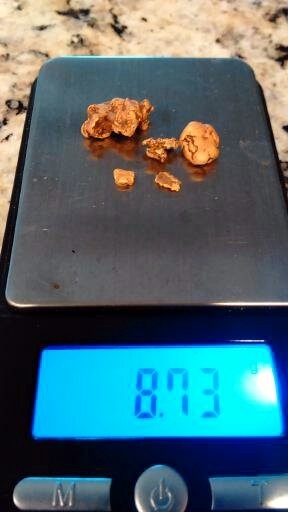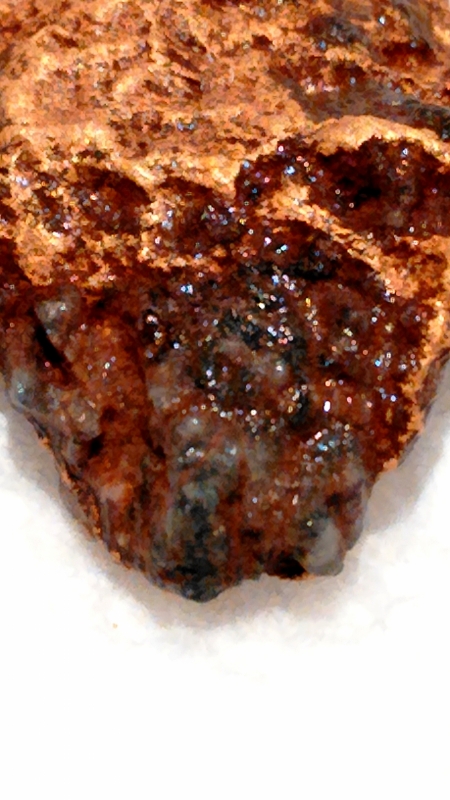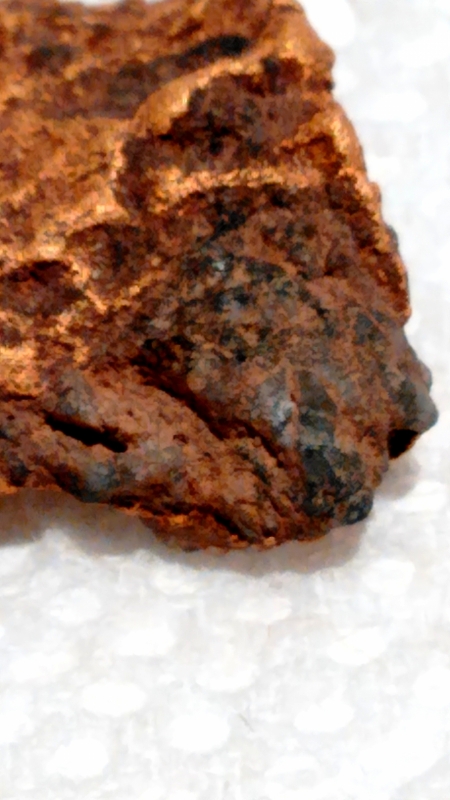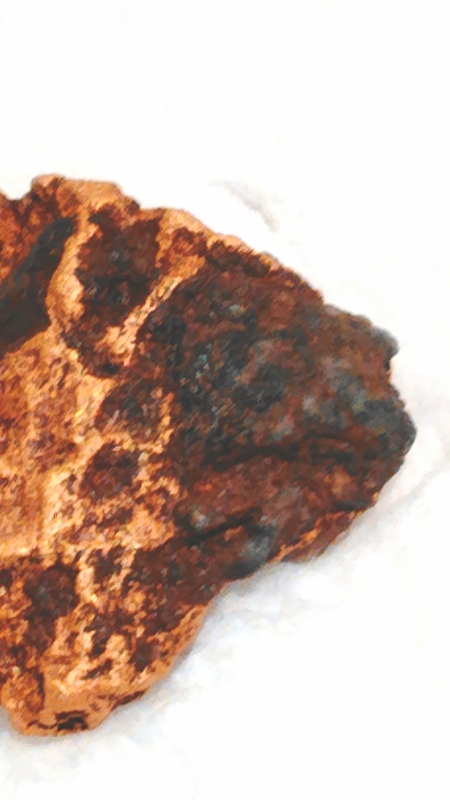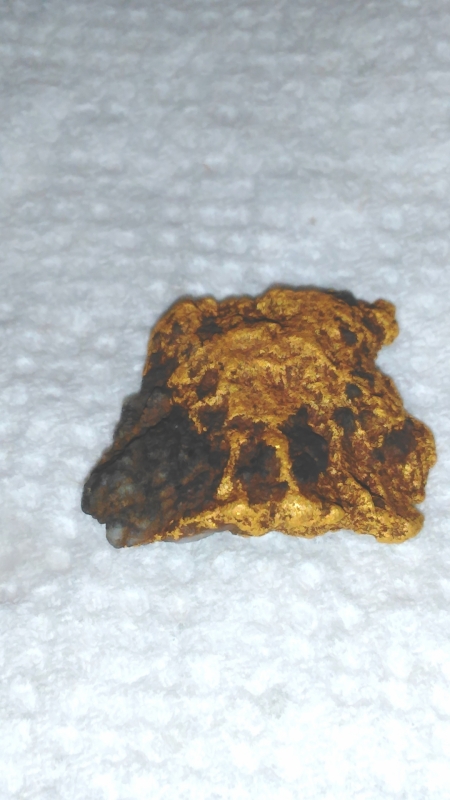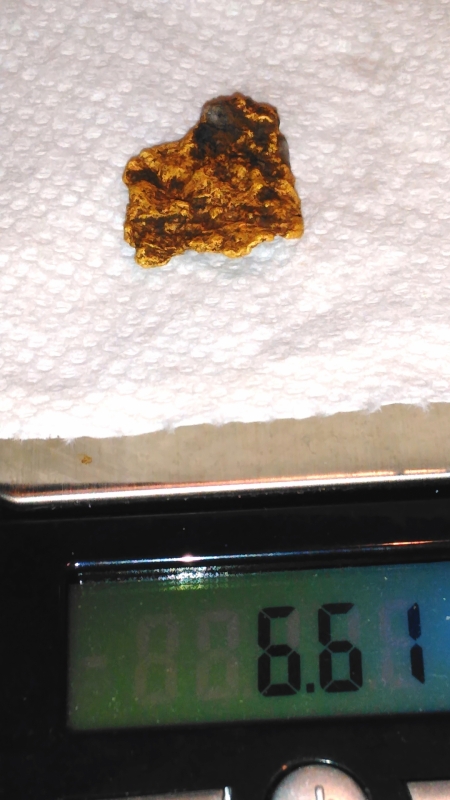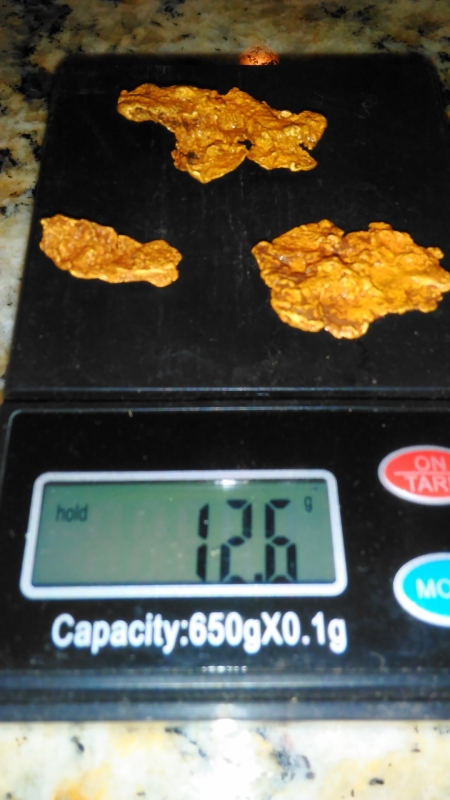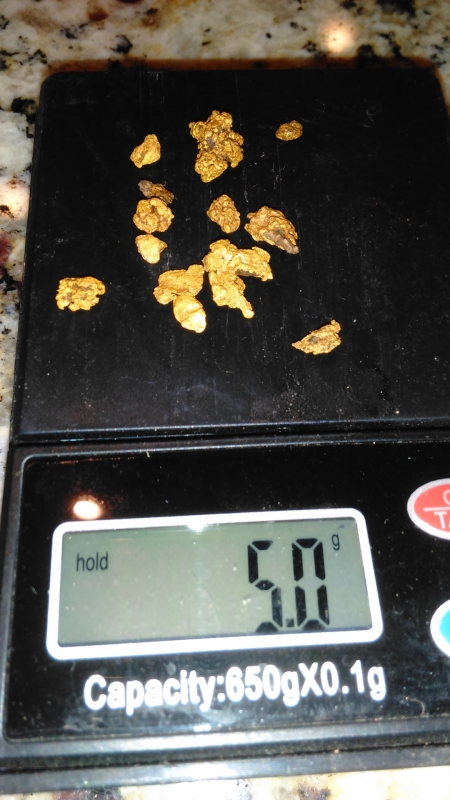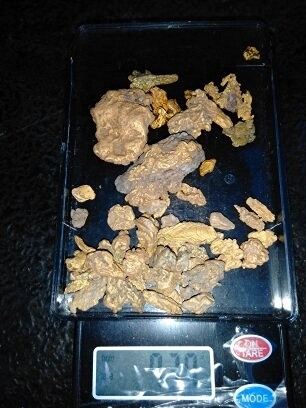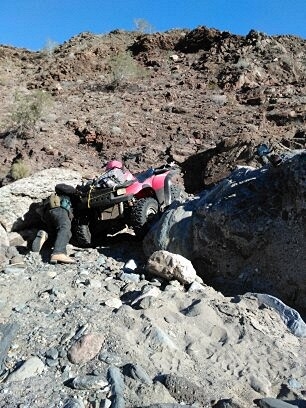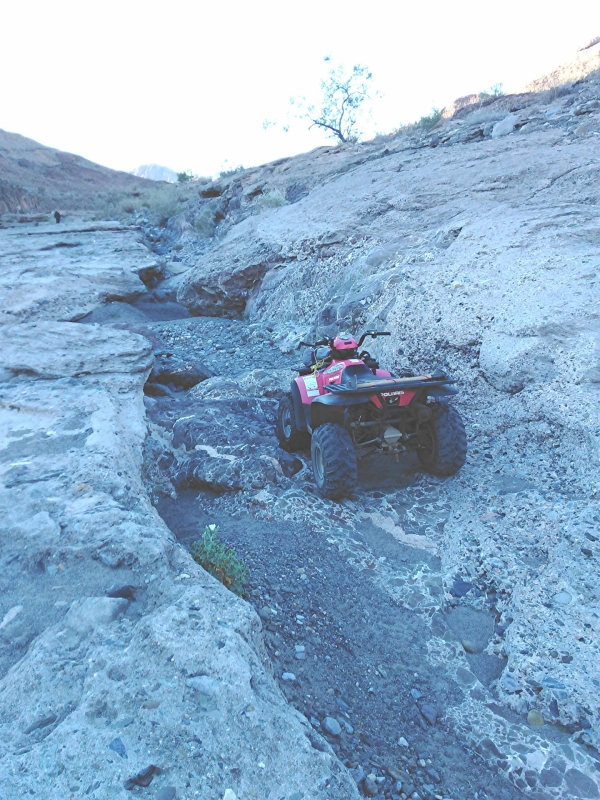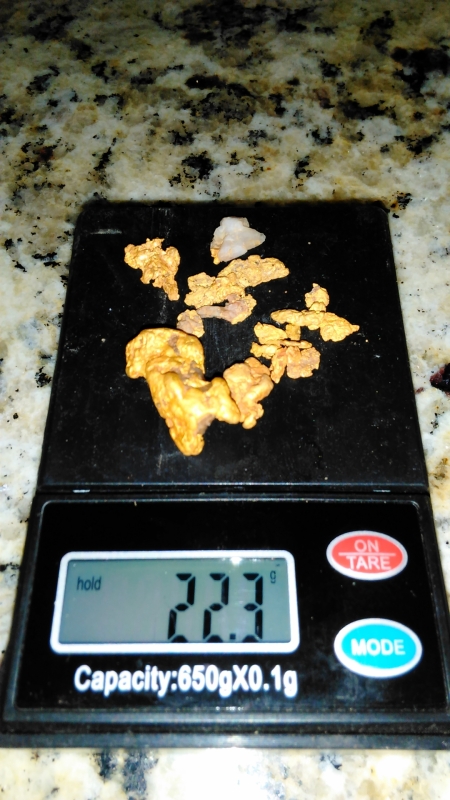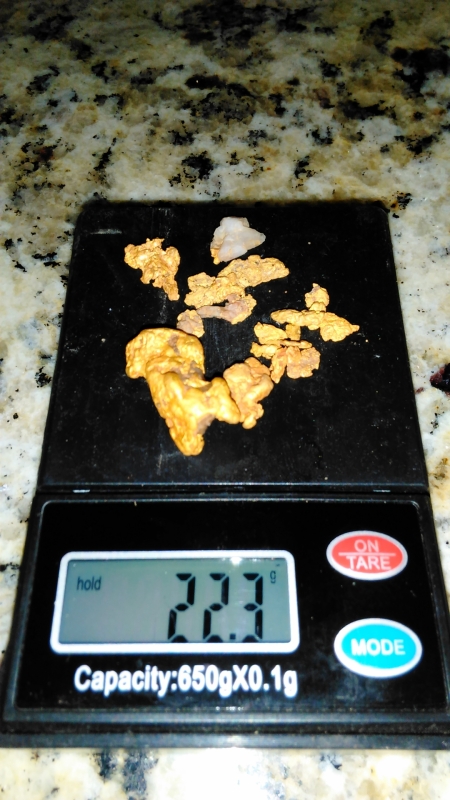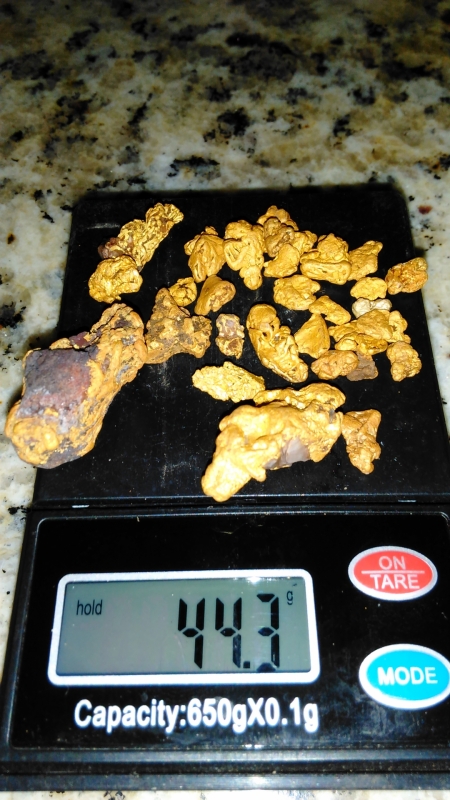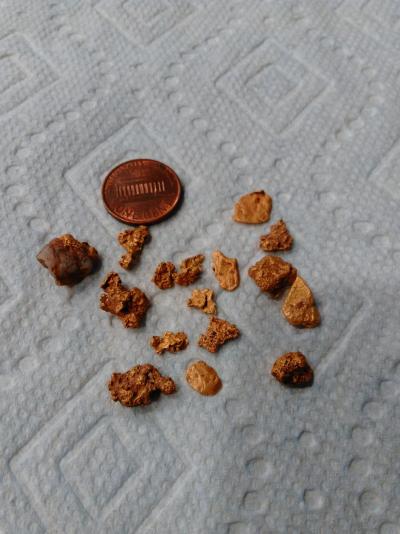
Condor
Full Member-
Posts
435 -
Joined
-
Last visited
Content Type
Forums
Detector Prospector Home
Detector Database
Downloads
Everything posted by Condor
-
As most of you know, I moved back to Sunny Yuma last year and I am literally 30 minutes from known placer locations. Unfortunately, these locations are no big secret and everyone and his dog have detected or drywashed these areas. I'm out there at least 4 days a week for 3 to 4 hrs at a stretch. I have hammered these areas dozens of times and lately have been down to finding a few tiny crumbs for my effort. I've been running the Insanely Hot settings just to eke out a few tiny bits and keep my interest up. I've reconciled this effort with the fact that I'm getting my morning exercise, fresh air and glimpses of desert wildlife. I consider it a successful week if I can find 2 grams, the price of a tank and a half of gas at $2.05 a gallon AZ prices. This morning I drove out to one of my least hammered areas, probably only been through there 6 times this year. I endeavored to stay out of the big washes and gullies and focus on the hillsides with short narrow washout zones that might concentrate some gold. They certainly concentrate .22 slugs, but .22s are mostly near surface targets and I don't waste too much effort. I had managed one tiny bit and noticed a gully that I had avoided in the past because the overburden gravels are too deep. I decided to give it a go and was surprised that at a higher elevation this gully flattened out and meandered between the hillsides totally hidden from normal view. No drywash tailings and no dig holes in a zone that had produced gold for me in the past. Obviously my photos reveal that there was indeed gold in the upper portion of that gully. The biggest nugget is 4.3 grams and was down 21 inches as measured on my pick handle. I was running wide open Insanely Hot settings, HY/Normal, Sens 20, smoothing off, threshold erratic at 21. The nugget was wedged up against a huge block of granite that prevented me from getting a decent swing of the coil. Several times the signal disappeared and the only way I could reacquire it was raising the coil about 4 inches above the hole and sweeping the coil briskly. You can't trust the Super D coil when poking it down into tight spots on a deep target, it really needs some side to side movement to be at its best. I don't think it was ground balancing the signal out, just not enough movement. So, a successful morning and I'm covered on gas for 4 more weeks, but summer is almost here and I imagine I'll work my way up to N. Nevada. I expect I'll see some of you boys up there soon.
-
The Minelab vs. Minelab thread and auto tracking got me wondering again. Perhaps Norvic, Lunk and JP can chime in and shed a little light based on actual field experience with changing ground conditions. About 3 weeks ago we had some rain here in sunny Yuma and the moisture really lit up the clay/silt layers. The Z got really noisy especially in my usual settings of HY/Normal with a sensitivity of 15 +. I tried a variety of changes and found that in order to cover a lot of ground I had to switch to HY/Difficult, Sens 12-. I could run my usual settings but had to slow down to a dead crawl and she still growled and moaned blurring any possible faint signals. Running in Difficult I did get a couple very faint signals but it auto tracked them out. I switched back to Normal and both signals were loud and clear. One of them turned out to be a tiny piece of gold, the other was a hot spot of red clay. What I didn't check was how far I could back off the sensitivity in Normal and still hear the targets. I'm wondering whether in this situation backing off the Sens beats switching to Difficult.
-
My SDC is nearing 2 years old although I haven't used it much since the 7000. There had been some audio issues with a worn headphone jack connection so I used duct tape to stabilize the whole mess but it was down to audio in just one ear. It's not the headphone cord, but the connection ring on the detector that was worn. A friend expressed interest in buying it and he called Minelab about getting it fixed on the warranty. He was told they don't repair the 2300's, just send it in and they would send out a new one. I know a couple guys here in Yuma that had audio problems with the 2300's and they have received a total of 3 new ones between them. Perhaps the steep price on the 7000 is helping to offset these warranty returns with the 2300. Hell of a way to run a railroad, but I'll be happy assuming a new one gets sent out as stated. I might have a brand new 2300 for sale real soon.
-
Jasong, I stuck mine in a weak acid bath of CLR and it did not fiz very much like your experience. This gold came from the predominately silver and lead areas of Yuma county. Gold was a by-product during smelting but obviously a few veinlets of gold must have formed, just never rich enough to interest the drywashers. A fellow prospector and I will explore the box canyon tomorrow. Fingers crossed.
-
I played with the camera a bit more. One photo dry nugget, one photo wet. The wet photo makes the matrix look like some quartz hidden in the black rock. I dunno, give me some ideas
-
Thanks for all the kind words. When I'm not out detecting I live vicariously for other people's prospecting adventures. I'm glad we have an active forum to share this hobby. I played around with my camera and photo editing to try and get a close up of the rock matrix on the nugget. Still not so good but maybe some of you experts can figure it out and give me an idea where to look for the vein. The nuggets I found last year all had the same matrix attached. There are hundreds of quartz veins in the area, but I haven't found any gold with obvious quartz attached.
-
6.61 grams, not oz.
-
I explored some new ground in Sunny Yuma this morning in an area that is not generally regarded as gold producing, more silver/lead. I had found some gold in the area last year with the SDC and figured the ZED should find some deeper ones. It turns out the last storms stirred up a bunch of old cans from a hard rock mine about 3 miles up the canyon. I quickly tired of digging trash and opted for a cross country trek. I hiked up and around a dry 30 ft waterfall to find a narrow gully with exposed bedrock. The gully was about 1/4 mile long and ended in a box canyon with 2 small feeder streams from the high ground. Halfway up the gully I get a screaming signal under a jumble of boulders. I had left the trash behind in the main wash and this little side canyon was pretty much undiscovered. I hadn't dug a single target so far so I was cautiously optimistic. I rolled a few big boulders and started digging,10 inches down the target was out. I had to turn the ZED sensitivity down to 1 to get the coil near the pile. On my second scoop into the pile I see yellow. Wow, a course nugget with host rock still attached. Whooee, I'm going to fill my pack with these babies, virgin ground that had never seen a detector. Well, I finished out the gully without another target. It was getting hot and I had a long walk back to the truck so I didn't explore the hillsides below the box canyon. Maybe next week I'll get up there and try to find the source.
-
I caught the stomach bug which kept me pretty close to home if you know what I mean. After 4 days of shut-in I was ready for some detecting. We had a bit of a break with cooler weather so I went back out to the area of the "short rich gully" to do some exploring. I put in 5 hrs of hard walking yesterday trying to find a new patch. I had avoided this particular zone in the past because it is littered with bowling ball sized volcanics and had some minor use by the old WWII desert warfare training folks. A fair number of jacketed bullets and mortar shrapnel are pretty common on the flats. After a lot of walking I dropped down into a shallow gully ready to round my loop back to the truck. I get a solid signal where I know bedrock is no more than 15 inches down. I hit bedrock and out pops a perfectly ugly, jagged piece of yellow. Nice, once I get my gear back in order 5 ft away I hit another good signal. Another flat, jagged piece of gold. Wow, that vein can't be far from here. I get going again and 50 ft away in a secondary flood channel I get a booming signal. Got to be a piece of shrapnel, the depth is no good, this target is in float gravel. 4 inches down out pops a 3rd piece of jagged gold. I am convinced I'm on the vein so I start a grid back and forth up and down both sides of the gully. No joy, plenty of shrapnel and bullets out there. I gave it a thorough go and no more gold to be found. I spent the night out there and got an early start this morning. All morning nothing but bullets and shrapnel so towards noon I start heading back to the truck. I'm bumping my coil along and I see a quartz outcrop ahead. I make a detour and bang, 1.5 gram piece right in the float off the quartz vein. I start a good search and find 10 pieces, some so small they won't register on my scale. The Zed continues to amaze me with those tiny bits. That quartz outcrop is a good 1/2 mile from the other big pieces from yesterday so I don't think that was the source. Hey Lunk, sorry to throw shade on your birthday nuggets.
-
Maestro has been detecting this spot for 25 yrs with the Gold Bug and SD2200. The gold we found was beyond the detection range of those detectors and the bedrock I found gold on had been uncovered by a storm in the past couple years. Any detector would have found that bedrock gold. We covered a lot of hard miles each day. Temps were mid 80's to 90's with a decent breeze. Still we each ran through 1/2 gallon of water each day. No trouble with locals, feds or military. 1 military checkpoint with a cursory examination of our gear. Mexican customs insists you have registration for the ATV when entering country. Very little trash even though there are miles of old drywash tailings. The Tertiary gravels had some horrendous hot rocks that make the Z operator dig a lot of holes for some deep rocks. I spent an hour trying to bust a booming signal out of caliche, but when I switched to Severe it disappeared. Just to be sure I put a .5 gram nugget down next to it and the nugget signal came through clear at 4 inches. Some more pictures. Maestro's gold and "big red" on the trail.
-
-
I didn't finish the first trip to Baja report and now have a second trip to report. Trip one was 10 days over 400 miles south of the border. We found gold nearly every day, mostly small pickers for me, but my guide, the Maestro found some nice 4 and 5 gram pieces. The last day the Maestro took us to rough looking gully where he explained that he had never found a lot of gold in this gully, but all were large nuggets. He gave me the lead and I worked up the gully to an area where more recent rains had eroded one side out of the main channel. Right away, a 2 grammer then 4 ft away a really nice signal. After about 30 minutes of digging into the bank and tumbling a big boulder out came an 11 gram slug. That brought my total up to 28 grams. The Maestro finished with I believe 38 grams. The Maestro consistently beats me for total weight. The main difference is that he will dig more questionable targets and he will spend more time with the coil on the ground when I'm exploring what's over that next ridge. A detecting style I will probably never break. Trip 2 was only about 200 miles south of the border, 5 days. We had to take "big red" my poor old beat up Polaris 500 ATV because of the distance to the placer zone. We rode double with the Maestro carrying his detector on a sling over his shoulders and my detector in his lap. Some rough sledding and "big red" had its difficulties with narrow rock chutes and steep rock climbs. One of the electronic parts that controls the cooling fan and charging circuit caught on fire. Using a mexican speed wrench, (vice grips) we took off the radiator housing to bypass the burnt part. One thing about the Polaris is its redundancy. We lost some cooling capacity and the ability to use the electric start, but we could pull start the old fashioned way. The only down side of pull starting is yanking when its on the compression stroke, ouch! Eventually yanked the rubber start handle right off on one of those compression strokes. The Maestro fashioned a new start handle out of a green tree limb and it will probably outlast the whole machine. But we found good gold. On day 2 I got into an area of bowling ball sized hot rocks and the Z really lights them up. I got frustrated and worked my way down to the main wash and an area of bedrock. One 50 ft section was loaded with up to 1 gram nuggets. I found 23 pieces in about 3 hrs. Maestro was his slow methodical self and pulled some multigram pieces up on the hillside and consistently outscored me in total weight. On day 4 I was off exploring and just pushing my coil along a high bench with some old Tertiary gravels. I got a screeching, warbling signal that surely sounded like trash but dug it just to see what the old timers had left behind. Out popped a 12 gram specimen nugget with quartz and host rock wrapped around it. I called the Maestro on the radio to have him come over to the new spot. I told him I had a nice piece convinced I had him beat for today's best find. He showed up an hr later and told me he had something to show me. He pulled out a beautiful 21 gram piece. Damn, I can't beat that guy, but we do enjoy the competition. We finished up this short trip with a good pile of gold. Maestro finished with 79 grams, me 48 grams. We did not see another soul out there in placer country. Saw desert BigHorn Sheep a couple times and the camp got raided by a pair of ravens. Crafty bastards punched holes in plastic water bottles and took whole bags of potato chips away with them. We named them Barack, since they perched up on the Ocotillo above our camp and shouted their names at us. Photos to follow from my camera phone.
-
Short Rich Gully Followup
Condor replied to Condor's topic in Gold Panning, Sluicing, Dredging, Drywashing, Etc
The storm concept makes good sense. This is actually a very shallow gully and not a desert wash. All the bigger nuggets I found last week were at the same midpoint and not on the bedrock. None of the tiny pieces I detected today were on bedrock. All were 3 or 4 inches down just below float gravel as it were. -
It was a genuine pleasure meeting with up with you and your brother here in sunny Yuma by the Sea. Same time next year I hope.
-
Short Rich Gully Followup
Condor replied to Condor's topic in Gold Panning, Sluicing, Dredging, Drywashing, Etc
Photos I hope -
Short Rich Gully Followup
Condor posted a topic in Gold Panning, Sluicing, Dredging, Drywashing, Etc
I went back out late yesterday to the super gully to give her a go with the drywasher. It is a couple hrs from home so I spent the night out there. I got there late and detected for about an hr before sunset. I found 1 small piece in the pile of one of my previous dig holes. This morning I decided to detect the whole works again with the Z maxed out settings with my high dollar earphones plugged in to boot. I found 10 pieces total. One 2 gram piece that I missed before and can only attribute to operator error on my previous outing. It should have been loud and clear without the maxed settings. The rest were all tiny pieces, so small that I detected them with the Z, but recovered them with the Gold Bug. Basically, if I got a repeatable warble in the Z threshold at maxed out settings, I dug until it was out of the ground then grabbed the Gold Bug Pro with the little 5" round coil to recover them. A good time saving measure if you're working a small area. Then I set up my puffer drywasher near the original dig holes. First thing I noticed was the dirt still had enough moisture that it clumped in the riffles. I ended up running it through 3 times from the tailings and wanted to abandon the effort. Nevertheless, I ran about 10 shovels full and decided to pan it out. Absolutely amazing, probably 20 colors with a couple tiny pickers in the pan. I punched 2 more sample holes in different areas just to check the results. Same thing, plenty of colors and a few tiny pickers. But, it seemed that the richest material was not at bedrock, maybe half way between or just above bedrock. I gave up the drywash effort because I know I'm losing gold in the damp soil and will opt for something new and more efficient in the future. Perhaps the Gold Cube set up to recycle water would do a much more efficient job. Photos to follow. -
I have hesitated posting this recent prospecting adventure, but do so with the following caveat: "Prospecting in Mexico is probably illegal. Law enforcement is arbitrary at best and bent for personal gain at worst. The roads are narrow with no shoulder. The landscape is rugged and unforgiving, services distant and cell phones useless. It's not for the faint of heart, don't do it if you can." Nevertheless, I'm an adventurer. I'm retired, divorced and my kids are grown so no one is depending on me for support. I have the luxury of risk taking because I'm the only one at risk. So last month my new friend from the "Pay it Forward" story decided to share his vast knowledge of placer gold from down the Baja peninsula. The placer zone is a well known area smack dab in the middle of the peninsula between the Pacific and Sea of Cortez. It's been prospected by drywashers for at least 100 yrs if not more. Detectorists both Mexican and American have been detecting down there since the advent of metal detectors. So we organized a 10 day trip taking 2 trucks. My guide and his longtime prospecting partner in one, and me in the other. We crossed the border at Mexicali at sunup and had breakfast and topped off our tanks in San Felipe. We took the back way, bone jarring, rough graded dirt roads from Puertocitos eventually coming out on Baja 1 near the turnoff to Bajia de Los Angeles. We stopped early the first day and prospected a small placer near the highway. Friend John found 1 nugget maybe 2 grams, I got the skunk and some nasty cactus in the soles of my boot and ankle. The next day we arrived at the "zone". We split up near an old hardrock mine, I eventually found a couple of dink nuggets in run off flats below the hills. From down in the brush I could hear a truck approaching, not a good sign. The track we were on hadn't seen vehicle travel in months. I stayed out of sight and friend John met slightly irate workers from an exploration company who made it clear that we were trespassing on company leased land. Oh well, we'll just have to keep a lower profile. A brief description of the terrain is in order. This is the harshest desert you will ever see and that coming from an old Arizona desert rat like myself. The flora if you can call it that is thickest in the seldom run water courses, the natural concentrating areas for placer gold. Every tree, bush and cactus has thorns, stickers, hooks, sabers and spines that will rip, stab and puncture your skin, as well as poke through a rubber boot sole. You are well served to have a leatherman tool handy to quickly get them out of lower legs and boots. There is no water and the bees will invade your camp to scavenge precious drops of moisture from beer and soda cans. In January the daytime temps were pushing mid 80's. Every wash, gully and canyon has been drywashed leaving behind a 100 yrs of nails, wire and rusted cans. My kind of place, the tougher it is the better I like it. Shoe clerks and manicured businessmen need not apply. My guide has been detecting here for over 20 yrs and has GPS coordinates for dozens of placer patches. We have arrived at each new spot when we see an old Coors Light can stuck to an Ocotillo limb. He remembers nearly every substantial nugget taken from these various patches and we trundle through them all. To be continued: I'm off to follow Jason's advice and drywash the short rich gully from the other day.
-
Jason, I was thinking the same thing about drywashing. Probably go back out next week. Unfortunately it's going to stay pretty warm in sunny Yuma.
-
-
I did a solo overnighter outside of sunny Yuma. Temps were hitting high 80's. I started at sunup and did a 2 hr loop with no gold, a few trash targets. I was working my way down the flats of desert pavement back to my truck when I decided to drop down into a shallow gully. Immediately I got a good tone and dug a small half gram nugget. 10 ft further on another nice mellow tone. 12 inches down I pull out a nice 1 gram nugget and after I gather my digging tools I wave the coil over the hole. Another target in the hole and one in the pile. I pulled 4 nuggets out of that one hole. 10 more feet further on another nice tone and I dig 3 nuggets out of the same hole all down 12 to 15 inches. My narrow Hodan pick is great for extending hiking and exploration, but really sucks for digging deep holes. I went back to my truck and took out the big boy pick and continued my search. The productive part of this gully was maybe 50 yds long and I took out 17 nuggets in the space of 2 hrs. A lot of digging. As I explored around the margins I saw old and faint shallow dig holes and boot scrapes. Then I noticed several dozen more recent shallow dig holes that had each been covered and marked with small piles of pebbles. I ran the Z through this margin zone and pulled one deep 1.5 gram piece from amid the shallow dig holes. I ran through the whole mess again and got four crumbs bringing the total to 21 nuggets weighed in at 14 grams. I'm pretty sure this spot was discovered by someone swinging a VLF and they apparently did pretty well on the shallow stuff. The ones I found in the gully were all stretched along a slow curved inside bend in the deepest part of the wash. Too deep for the VLF I suspect. I poked around all day and part of the next for no joy. My first respectable patch and it ended too soon. I'll follow up with a photo from my phone, I'm still too dense to sync these things together.
-
I can say positively that I noticed a difference after the upgrade. My Detector was constantly drifting into a negative ground balance especially running in hot ground or a lot of hot rocks. The threshold kept banging every time I lifted the coil off the ground. I accidentally fat fingered the reset the other day and I had a hard time getting the ground balance to ignore the ferrite. I went through the new ground balace process 3 times before I got it close, but it never did ignore the Ferrite at high Sens settings. I dropped Sens down to 12 and let go at that.
-
I have seen places here in AZ where wet/dry cycles and freezing/thawing cycles push rocks to the surface and ultimately push fence posts right out of the ground. There are similar theories about our "desert pavement" which often overlays hundreds of feet of rocks and clay. I see dozer cuts through the desert pavement and there is no underlying stratification. Just random rocks and clay type soil.
-
In my inartful response I neglected the role of physics and gravity that guides my economic sense. It's well established that due to its specific gravity, gold, over time will continue to settle to its lowest point until something stops it. Desert washes run perhaps twice a year, and have catastrophic floods at best once or twice in our lifetime. When you see a 20 ft high cut bank with the strata of thousands of years of flowing and flooding you get the big picture. The occasional big flood may dislodge gold from its hiding place and throw it into the outwash gravels, but it's not a regular event and not worth spending a lot of time pursuing. The gold got laid down in those gravels thousands of years ago, a .22 cartridge casing or lump of aluminum foil got laid down in our lifetime and they lack the inherent density of gold to settle at those bottom levels. So, if you spend your time in outwash gravels you'll find the detritus of our recent human activity and not the dense gold that has perhaps settled beyond detection range. The fact that someone found a huge chunk of gold in dredge tailings doesn't change the role of gravity because in all likelihood that gold was resting at its lowest level until acted on and unfortunately discarded by the dredger. My tortured point is that especially in the desert southwest, I concentrate my efforts in areas that have not only produced gold, but contain settling bottom areas that are reachable with modern electronics. My own personal detecting guidelines, "deep outwash gravels, no bueno". I want to stick to those areas where I have the greatest opportunity to detect and recover gold in its lowest level hiding place. My apologies for belaboring the point.
-
Seriously Chris? The logic of hunting a tailings pile certainly differs from hunting desert gravel washes where this thread started. For me it's a matter of simple economics. I could spend my time in deep gravel washes and get plenty of targets and a very small minority of them will be gold. But, there is a cost. The cost is both opportunity lost and physical effort expended. Digging deep targets in desert gravel is no easy chore and a very time consuming one. A two foot deep hole might end up being 3 ft wide because the sides keep caving in. Then there is the economics of my physical effort. My 61 yr old frame only has precious few deep hole digging hrs available during a given day. If I use them up chasing deep trash then I am no longer available to dig better targets. Just yesterday I got a decent target in an obviously float gravel wash. I could see from the exposed bank that bedrock was probably about 2 ft down. So I dug straight down hoping to find a bottom layer of muck or clay that might hold a nugget. No luck without an ever expanding hole but fortunately the target came out after about 15 inches down. Of course it was junk, but I knew that going in and decided to chase it if I thought I could find a bottom. For me, it's the percentages that matter. There is simply no advantage for me to swing my coil over deep desert gravel washes because I will find targets and then what, dig them or walk away. Am I missing gold? Of course I am, but I choose to spend my time over targets that have a higher percentage of being recoverable gold at a lower cost of physical effort.
-
Revisiting Steve's Insanely Hot Settings
Condor replied to Condor's topic in Minelab Metal Detectors
I'm sorry I missed answering part of your question. Yes, I want to keep my data from a previous trip because my ground in in Yuma by the Sea stays fairly equal. I don't think my ground "reactivity" changes that much in my local area, so I'm happy with keeping the previous data and settings, and letting the data build with whatever new location I'm in.

